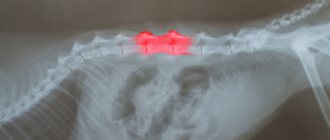Heart attacks in dogs occur in any breed and at any age. The death of part of the heart muscles, or a heart attack, is a serious pathology that causes an irreparable blow to the entire blood system and the functioning of blood vessels. Poor circulation, as well as a disturbed cardiovascular system, very often provoke serious problems. Like people, our pets also often experience this pathology.
If the owner of the animal has doubts about the health of the pet, or needs necessary medical assistance, you should immediately contact a veterinary clinic for a consultation. After a heart attack, the animal requires special care, as well as constant medical supervision. Prevention of heart disease should be carried out throughout the life of the animal.
What is a heart attack
Many people have heard about this pathology, but not everyone knows what a heart attack is. In this case, “attack” is a somewhat incorrect term, since it indicates the consequences, but not the cause. Essentially, a “heart attack” is the death of some part of the muscle tissue of the heart itself (due to a heart attack or thrombosis).
Considering how important the heart is for the body of any living creature, one should not be surprised at the severity of the consequences of its partial inoperability. It is what happens to the animal at the moment of heart rhythm failure that is called an attack. Let us note that heart attacks in dogs are quite rare, but this is due not so much to their actual rarity as to the large number of deaths and “sudden deaths.”
Restrictions
Veterinarians have differing opinions regarding the use of Corvalol for pets. Some believe that the presence of barbiturates in the drug can cause instant death, but in fact their content in the drops is minimal, so if the dosage is observed, the medicine cannot cause harm.
However, taking Corvalol should be prohibited for animals suffering from hypersensitivity to the components of the drug, liver or kidney pathologies. Heart drops should not be given to pregnant or lactating females.
Violation of the dosage can cause negative manifestations in the form of diarrhea, abdominal pain, and skin reactions. The acute form of poisoning is manifested by confusion, drowsiness, and loss of coordination in space.
The main causes of a heart attack in a dog
Causes of a heart attack in a dog:
- In older dogs, tumors can grow directly into the heart muscle tissue. They not only compress normal muscle tissue, but also “take away” nutrients and oxygen from it. As a result, the death of part of the muscles and the development of an attack.
- Hyperthyroidism , i.e. dysfunction of the thyroid gland.
- Kidney problems. The adrenal glands secrete important hormones involved (including kidney problems) in regulating blood pressure. After nephritis or nephrosis, this process may be disrupted, the animal begins to suffer from hypertension, and this is fraught with serious heart pathologies.
- Infectious diseases of viral and bacterial etiology. If the pathogen gets into the blood (and this will definitely happen), it will quickly end up in the heart. The consequences of his life activity can be completely unpredictable. In particular, some infections are fraught with the development of inflammation of the walls of blood vessels (this is called vasculitis). If the vessels of the heart muscle itself are inflamed, normal trophism and oxygenation of the organ are disrupted, which threatens the development of an attack. Distemper especially often ends with a heart attack.
- Atherosclerosis. With this pathology, the inner surface of the blood vessels is covered with cholesterol plaques. Having come off, the latter can clog the lumen of blood vessels in the heart itself, which will lead to rapid tissue necrosis and cause an attack. This disease is extremely rare in dogs.
- Pathologies of the coronary arteries. As a rule, their appearance is a consequence of extremely high levels of cholesterol in the blood. In dogs, however, this disease is vanishingly rare.
- Poisoning. If the toxin is quite “vigorous” and has managed to enter the blood in sufficient quantities, the heart will feel bad.
- Acceleration of ESR, increase in blood viscosity. In this case, the blood becomes so thick (due to dehydration or intoxication, for example) that it is very difficult for the heart to pump it through the entire body. In addition, such blood flows much worse through small blood vessels, which negatively affects the trophism and oxygenation of heart tissue.
Symptoms of cardiac arrest
In more than half of cases, cardiac arrest occurs without symptoms, as a “sudden event.” However, some patients experience a range of symptoms in anticipation of the problem. These include:
- Rapid heartbeat or extreme heartbeat.
- Feelings of dizziness and disorientation.
- Loss of breath and chest pain.
Although these indicators can predict cardiac arrest, most people will be alerted to it by the most severe symptoms, such as sudden weakness or loss of consciousness. In most cases, it is therefore very difficult to distinguish a stroke from a heart attack in advance.
Age and breed characteristics
There are certain age and breed characteristics that slightly increase the risk of heart attacks in some varieties of these animals. Of course, this does not mean that representatives of certain breeds die from heart attacks, but the health of their cardiovascular system must be monitored more closely.
Heart attack in older dogs
Heart attacks are most common in older dogs because their organ systems are already worn out and do not have sufficient strength reserves. This is especially typical for elderly “giants”, i.e. dogs of large and extra large breeds.
Such animals have an impressive body size, but their heart size is not too different from that of a wolf. Because of this, the organ of such dogs works every day under enormous overload, which leads to its pathologies. The predisposing factor in this case is considered to be improper maintenance during puppyhood: when the pet’s body grows quickly, the heart cannot keep up with it. You can’t overload the puppies! The intensity of training before the age of one year should be minimal!
Seizure in small breed dogs
Seizures occur much less frequently in small breed dogs. The body size of such dogs is small, and it is much easier for their heart to pump blood throughout the body.
Therefore, they have attacks only in the presence of serious predisposing factors:
- Very poor and unbalanced feeding at an early age. This will inevitably manifest itself in the future (but not necessarily in the form of a heart attack).
- Parasitic diseases. Heartworm is especially dangerous.
- An attack in “kids” is a common consequence of previous infectious pathologies (especially viral ones).
Dosage
Corvalol can be given to dogs in two ways. The safest way is to use the drug without taking it orally. This allows you not to make a mistake with the dosage and avoid dangerous side effects of the drug.
A few drops of Corvalol tincture should be dissolved in a small amount of water and placed in a saucer at a distance of 12-15 cm from the animal. There is no need to water your dog! You can moisten a cotton swab in this mixture and bring it to the animal’s face at a distance of 10 cm.
Oral administration of the drug requires strict adherence to the dosage. It will be installed by a veterinarian after examining the animal. Corvalol is not a systemic drug; it can only be used as an emergency aid for an animal. For medium-sized dogs (15-30 kg) you need to dilute 10-12 drops in a tablespoon of water; for small animals (up to 15 kg) this dose should be halved. Large and giant dogs can be given up to 30 drops dissolved in water.
Symptoms and first signs of a heart attack in a dog
If the owner notices any symptoms and the first signs of a heart attack in a dog, it is necessary to immediately call a veterinarian. You need to pay attention to the following:
- The dog's body temperature may rise or fall sharply.
- Vomiting is often observed (its appearance is associated with surges in blood pressure).
- All visible mucous membranes turn very pale or blue.
- The animal begins to breathe unnaturally and strangely.
- The initial stages of an attack are characterized by a sharp increase in heart rate.
- The pet becomes very lethargic and apathetic.
- You may notice a strange tilt of the dog's head.
- The animal shows painful anxiety and behaves strangely (as in the case of people, the clouding of consciousness affects it).
- After this, the stage of convulsions and seizures usually begins, but this does not last long.
- As a rule, the animal falls into a deep faint, which may well develop into a coma.
- After this, the dog either comes to his senses or dies (unfortunately, this happens more often).
Types of heart failure
Chronic heart failure develops slowly. Often its development occurs against the background of infectious diseases.
Symptoms of the chronic form are often invisible; the pet only has a cough, which the owner does not pay attention to.
Acute heart failure progresses quickly, sometimes within hours or even minutes.
The acute form can lead to the immediate development of pulmonary edema, the symptoms of which are blood from the mouth and nose, and a severe cough.
First aid for a dog at home
Let us warn you right away: first aid for a dog at home in case of a heart attack is ineffective; we recommend immediately calling a veterinarian at the first sign. It sounds trivial, but in practice nothing more useful can be done. But it's still worth a try.
- If, immediately after the development of the first symptoms, you give the dog 5 drops of cardamine or 6 to 16 drops of Corvalol (the exact amount depends on the weight of the pet), the attack can often be stopped.
- If the pet shows signs of confusion, it has convulsions, spastic twitching of the limbs and similar signs, it is necessary to speak kindly to the dog, pet it, and reassure it in every possible way.
- There is no need to run around your pet in a panic: this will not help stop the attack, but excess stress will almost certainly worsen the animal’s condition.
- But! If the dog demonstrates aggression, it is necessary to put on a muzzle before “calming measures”. During an attack, the animal has no control over itself, and therefore can bite hard!
- If your dog has breathing problems, you can give him aromatic salt to smell. There is no need to give ammonia, as it burns the mucous membranes of the nose, causing a severe chemical burn!
Important! No “heart massage” or other extreme methods. If the owner does not master these techniques perfectly, he will only break the dog’s ribs and finally finish him off!
Stroke
Stroke, also known as CVA, is actually a brain disorder that is often (but not always) caused by heart problems. This occurs when blood flow to the brain is reduced to the point where cells in the brain begin to die. There are two main types of stroke:
Ischemic: Resulting from blockages in the arteries, resulting in a lack of blood flow to the brain and the death of brain cells. This type of stroke involves the heart and circulatory system and is often confused with a heart attack or cardiac arrest.
Hemorrhagic: Caused by bleeding, usually caused by a rupture of an artery in the brain itself. They can sometimes be associated with traumatic injuries to the head, although the impact may occur long after the initial incident.
What are the symptoms of each condition?
All of these conditions can develop very suddenly, but there are often a number of indicators that people can use to help identify a developing problem. Some of the symptoms may be shared between the two conditions, but there are some differences that can help you tell them apart:
Treatment regimen for a dog after a heart attack
Here is an approximate treatment plan for a dog after a heart attack:
- The first step is to prescribe adrenaline, as it stimulates cardiac activity.
- The dog must be provided with complete rest; any physical activity is excluded for at least three weeks. Starting from the second week, the dog can already be taken outside, but only for 15-20 minutes. No physical games, running after a stick/ball, etc.
- The dog is prescribed diuretics for approximately 5 days after the attack. These drugs ensure the removal of excess fluid from the body, which prevents the development of edema (including pulmonary edema).
- So-called ACE inhibitors are required. They normalize the lumen of blood vessels, including coronary ones, which feed the heart muscle itself.
- So-called cardiotonics are also needed. These medications normalize myocardial contractility, which has a positive effect on the recovery of the body.
At least once a week from the start of therapy, the dog is shown to the veterinarian for treatment correction.
Symptoms of a stroke
Many of the early symptoms of a stroke are neurological and may begin to appear in the weeks and months before the attack. Symptoms to watch out for include:
- Severe headaches that may be accompanied by a feeling of dizziness.
- Confusion, forgetfulness and memory loss. Inability to speak clearly or remember anything from the past.
- Blurred vision in one or both eyes and slurred speech.
- Coordination problems leading to problems walking or lifting objects.
- Nausea, illness and excessive sweating.
- Partial or complete loss of feeling and function in the arms, legs and mouth. It usually affects one side of your body.
What is commonly confused between these disorders?
It should be noted that during a heart attack the heart continues to beat, but during cardiac arrest it stops altogether (or the power of the beating is significantly reduced) due to an electrical malfunction. Those who have previously had a heart attack are at greater risk of cardiac arrest.
Doctor
A heart attack is also more likely to occur as a result of symptoms gradually developing and worsening over time (although sometimes, people can have a heart attack despite having no symptoms at all - a condition known as a "silent" heart attack).
Stroke symptoms, meanwhile, vary and usually affect the sufferer's head or motor skills. Since the causes of stroke can be attributed to the heart's inability to pump enough blood to the brain, it actually occurs as a result of sudden cardiac arrest (which is actually one of the main causes of stroke).
What should you do?
You do not need to live in fear because of any disorder, but you should always contact your doctor if you have any concerns that you have such symptoms. Heart attacks and strokes in particular do often provide notice of an upcoming event, and treatment can prevent disaster.
The best ways to ensure that you do not have such problems are to live a healthy lifestyle, avoid bad habits, eat well and exercise regularly. Also, see your doctor for regular checkups, especially if you have any symptoms that may be related to these conditions.
Consequences of a heart attack in dogs
As you might guess, the consequences of a heart attack in dogs are extremely serious:
- Severe neurological pathologies, including epilepsy. Their development occurs if the pet’s cerebral cortex has been left without oxygen and nutrients for a long time. At first, nothing unusual is noticed about the dog, but the consequences of oxygen starvation may appear after a couple of years. Therefore, a pet who has suffered a heart attack needs to be looked after especially carefully and shown to the veterinarian more often (during the first year - at least once every two months).
- A heart attack does not go away without a trace even for the heart itself. Dead areas always remain, which are subsequently replaced by connective tissue “patches”. Because of this, the heart can no longer contract as efficiently, and the risk of developing valve pathologies and other diseases leading to heart failure increases.
- The animal cannot endure physical activity with the same vigor ; the dog no longer runs so dashingly after a stick or ball and no longer runs so willingly with its relatives.
- The risk of developing edema increases sharply. An ill dog often suffers from cold swelling of the chest, groin, and paws. They are a clear indication of heart failure, and such animals should be regularly examined by a veterinarian and prescribed supportive treatment.
How does tachycardia manifest?
The state of the heart can be quickly determined by the heart rate (HR) - through the pulse, which can be easily felt in large peripheral arteries. Normally, its frequency coincides with the heart rate, since the pulse is the response of the arteries to the ejection of blood from the heart when it contracts. Indicators for a healthy person are 60–80 beats per minute. If your heart begins to beat faster, it may physically feel like it is jumping out of your chest.
However, this does not always happen, and then the presence of tachycardia can be suspected based on a number of other symptoms.
Different pacemakers (sources of impulse generation) are responsible for different types of tachycardia.
Clinical signs of tachycardia
- Pain or discomfort in the chest.
The chambers of the heart contract alternately: while some parts are filled with blood, others are resting. The stronger the tachycardia, the shorter the periods of myocardial relaxation. Working without rest causes pain in the heart.
- Dizziness and general weakness.
In the pulmonary circulation, blood oxygenation (oxygen saturation) occurs. With tachycardia, the time required for complete gas exchange decreases. Rapid contractions of the heart release blood into the vascular bed with a reduced content of O2, which is why the tissues do not have enough of it. To make it easier for organs to receive it, vascular resistance decreases. This results in a compensatory decrease in pressure in the blood vessels, accompanied by dizziness and general weakness. Sometimes it can lead to loss of consciousness.
- Dyspnea.
It occurs both during movement, since during physical activity the body requires more oxygen, and at rest - if tachycardia persists for a long time. The same oxygen starvation leads to the development of shortness of breath: increased breathing is an attempt to restore oxygenation.
- Cyanosis, or blueness of the skin.
With hypooxygenation (decreased oxygen concentration in the body), the blood contains a large amount of reduced hemoglobin, a substance responsible for binding oxygen. Low oxygenation leads to cyanosis of the lips, tips of the ears, or fingers.
Tachycardia can be expressed by less significant symptoms: cough, headache, nausea, sleep disturbances, decreased appetite and performance. These complaints are not typical for an increase in heart rate, but you should mention them when visiting a doctor
Prevention measures
The following preventative measures will significantly reduce the risk:
- Balanced feeding, consistent with age, breed, physiological characteristics. The dog should not gain weight, but at the same time, his body should receive all the necessary nutrients, micro- and macroelements.
- It is necessary to normalize physical activity at an early age. The dog is growing quickly, but his heart is growing much slower in size. No need to overload it.
What is intercostal neuralgia?
Neuralgia of the intercostal nerves is pain of a different nature that occurs due to various etiological factors. It is more often observed in adult men and women over 30-35 years of age. Symptoms of neuralgia may appear suddenly on one or both sides of the chest, along one or more intercostal nerves. The disease has an ICD code - M.79.2.
To understand what intercostal neuralgia is, you should understand the anatomical features of the thoracic nerves. There are 12 pairs in total. Each intercostal nerve contains motor, sensory and sympathetic fibers. It originates from the anterior roots of the spinal cord of the thoracic spine, passes along the lower edge of each rib, reaching the sternum. The parietal pleura covers the nerve fibers on top.
Thoracic nerves transmit impulses to the skin, the musculo-ligamentous apparatus of the chest and the anterior wall of the abdomen, partly the pleura and peritoneum, and the mammary glands. Sensitive fibers of neighboring nerve trunks actively interact with each other, creating cross innervation.
Neuralgia during pregnancy
If intercostal neuralgia appears in a pregnant woman, how to diagnose it and how to treat it is decided by a neurologist together with a gynecologist. Therapy is selected taking into account possible negative effects on the fetus. Self-medication in this situation is considered unacceptable, as this can have a negative impact on the health of the expectant mother and child.
To prevent chest neuralgia from appearing during pregnancy, it is advisable to follow preventive measures. If a woman has previously had attacks of thoracalgia, then at the stage of preconception preparation she should visit a neurologist and osteopath. The doctor will conduct a diagnosis, and then the neurologist will give a number of recommendations on how to treat intercostal neuralgia. An osteopath will identify possible causes of neuralgia and conduct a treatment session aimed at eliminating them.
Forms of the disease
Chest neuralgia can be primary (an independent pathology) and secondary (a symptom of another disease). There are also radicular and reflex forms of the disease. In the first case, symptoms of intercostal neuralgia on the left and right arise due to irritation of the spinal roots. The second type of pathology occurs due to a negative effect on peripheral receptors.
In addition, clinicians distinguish the following types of thoracic neuralgia:
- musculoskeletal;
- vertebrogenic;
- spicy;
- chronic;
- right-sided;
- left-handed;
- psychogenic;
- during pregnancy.
Intercostal neuralgia of a certain type has its own characteristic symptoms and treatment features.











